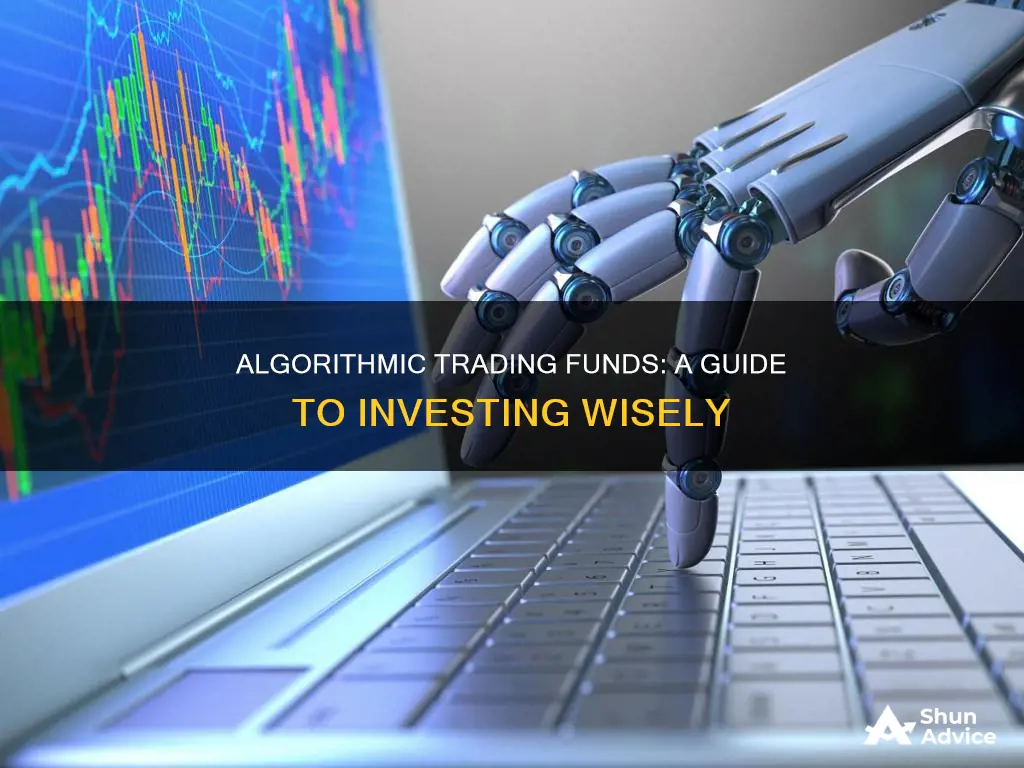
Algorithmic trading is a popular investment strategy that uses computer programs to automate the process of buying and selling financial instruments. It is a form of automated trading that employs complex algorithms and mathematical models to identify profitable opportunities in the markets. This approach offers several advantages, such as faster and more accurate decisions, the ability to analyse large amounts of data, and the elimination of human emotions and errors from the trading process. However, there are also disadvantages and risks associated with algorithmic trading, including high capital costs, the potential for increased market volatility, and the possibility of system failures and technical issues. Before investing in algorithmic trading funds, it is crucial to carefully consider the potential benefits and drawbacks, ensure a solid understanding of the financial markets, and determine if this strategy aligns with your investment goals and risk tolerance.
| Characteristics | Values |
|---|---|
| Definition | Uses a computer program that follows a defined set of instructions (an algorithm) to place a trade |
| Trade Criteria | E.g. Buy 50 shares of a stock when its 50-day moving average goes above the 200-day moving average |
| Advantages | Best execution, low latency, reduced transaction costs, no human error, backtesting |
| Disadvantages | Latency, black swan events, dependence on technology, market impact, regulation, high capital costs, limited customisation, lack of human judgement |
| Common Strategies | Trend-following, arbitrage opportunities, index fund rebalancing, mathematical model-based, trading range, volume-weighted average price, time-weighted average price, percentage of volume, implementation shortfall |
| Technical Requirements | Computer programming knowledge, network connectivity, access to market data feeds, backtesting ability, historical data |
| Monetisation Options | Start an investment fund, use it to invest yourself, create a trading signal service, sell the algorithm |
| Tools | Back-testing platforms, risk management systems, quantitative analysis tools, order execution systems, portfolio optimisation tools |
What You'll Learn

Understanding the basics of algorithmic trading
Algorithmic trading (or algo-trading) is a process that uses computer programs to automate the buying and selling of financial instruments such as stocks, currencies, cryptocurrencies, and derivatives. It is also referred to as automated trading or black-box trading. This type of trading is based on a defined set of instructions or algorithms that are coded into a computer program, which then executes trades at precise moments. Algo-trading is particularly useful when attempting to take advantage of specific market behaviours, such as a change in price, volume, or time.
Algo-trading relies on a set of simple instructions or criteria to execute trades. For example, a trader may instruct a computer program to buy 50 shares of a stock when its 50-day moving average goes above the 200-day moving average and to sell when the 50-day moving average goes below the 200-day moving average. The computer program will then monitor the stock price and place buy and sell orders automatically when the defined conditions are met, without the need for manual input from the trader.
Advantages of Algorithmic Trading
Algo-trading offers several benefits over traditional trading methods. These include:
- Best Execution: Trades are executed at optimal prices.
- Low Latency: Trade orders are placed instantly and accurately, reducing the risk of significant price changes.
- Reduced Transaction Costs: Algo-trading can lead to lower fees and costs.
- No Human Error: Removing human input reduces the risk of manual errors and emotional factors influencing trade decisions.
- Backtesting: Algo-trading strategies can be tested using historical and real-time data to determine their viability.
Disadvantages of Algorithmic Trading
Despite its advantages, algo-trading also has several drawbacks. These include:
- Latency: Algo-trading relies on fast execution speeds and low latency. If trades are not executed quickly enough, opportunities may be missed or losses may occur.
- Black Swan Events: Algo-trading uses historical data and mathematical models to predict market movements, but unforeseen disruptions can occur, resulting in losses.
- Dependence on Technology: Algo-trading is vulnerable to technical issues and failures, which can disrupt trading and lead to losses.
- Market Impact: Large algorithmic trades can influence market prices, affecting traders who are unable to adjust their trades accordingly.
- High Capital Costs: The development and implementation of algo-trading systems can be costly, and ongoing fees for software and data feeds may be required.
Getting Started with Algorithmic Trading
To begin with algo-trading, individuals must have access to a computer, a network connection, knowledge of financial markets, and coding or programming skills. It is important to have a solid understanding of the market and the ability to transform trading strategies into executable algorithms. Additionally, backtesting, or testing trading strategies on historical data, is a common practice to evaluate the performance of an algorithmic strategy before it goes live on the market.
Vanguard Funds: Best UK Investment Options
You may want to see also

Exploring the pros and cons of algorithmic trading
Algorithmic trading, or algo-trading, is a mechanism where computer-generated algorithms are used to execute trades based on a set of predefined rules. This method of trading offers several benefits and drawbacks that traders should consider before implementation.
Pros of Algorithmic Trading:
- Increased Speed and Accuracy: Algo-trading offers faster trade execution, capturing price movements as soon as they occur. It also minimises human errors and ensures trades are executed with maximum accuracy.
- Decreased Cost: Algo-trading enables the execution of large volumes of trades in a short period, reducing transaction costs.
- Minimisation of Human Emotions: Algo-trading reduces the impact of human emotions, such as greed or fear, on trading decisions. It helps maintain discipline and consistency in the trading process.
- Improved Order Entry Speed: Algo-trading systems respond immediately to changing market conditions, generating orders as soon as trade criteria are met, which is crucial for capturing price movements.
- Diversification: Algo-trading facilitates diversification by allowing the execution of multiple trades and strategies simultaneously.
- Backtesting: Algo-trading strategies can be backtested using historical data to evaluate their viability and profitability before live implementation.
Cons of Algorithmic Trading:
- Dependence on Technology: Algo-trading is highly dependent on technology, and any failures or disruptions can result in missed opportunities or losses.
- Loss of Human Control: Algo-trading is fully automated, leaving no room for human discretion. Traders cannot intervene if they anticipate that the strategy might not work as intended.
- Constant Monitoring: Algo-trading systems require constant monitoring to address potential mechanical issues and ensure successful trade execution.
- Technical Knowledge Requirement: Algo-trading demands technical expertise in programming and algorithm development, which may be challenging for non-technical investors.
- Over-Optimization: Strategies that appear successful on paper may not yield the same results in live trading due to over-optimization, where the strategy becomes unreliable in real-world market conditions.
- Resource-Intensive: Algo-trading requires significant resources, including high-end technology, access to servers, and costly data feeds, which can be a barrier for individual traders.
- Regulations: Algorithmic trading is subject to complex regulatory requirements and oversight, which can be time-consuming and restrictive.
- Limited Customisation: Algo-trading systems follow predefined rules, limiting traders' ability to customise their trades to meet specific needs or preferences.
- Inability to Understand Irrational Markets: Algo-trading relies on mathematical models and historical data, struggling when market behaviour deviates significantly from historical patterns.
Adani's Success: Mutual Funds Investing in the Giant
You may want to see also

Examining the technical requirements for algorithmic trading
Algorithmic trading is a complex process that requires a strong understanding of computer programming, financial markets, and trading strategies. To successfully implement algorithmic trading, several technical requirements need to be met. Here are the key technical aspects to consider:
- Computer Programming Knowledge: Algorithmic trading relies on computer programs to execute trades based on predefined instructions. Proficiency in programming languages such as Python, Java, C++, or MATLAB is essential for developing and implementing trading algorithms.
- Network Connectivity and Trading Platforms: Access to robust network infrastructure and reliable trading platforms is crucial for algorithmic trading. Traders need a stable connection to place orders and interact with financial markets in real time.
- Market Data Feeds: Algorithmic trading systems require access to real-time market data feeds. These feeds provide essential information such as stock prices, currency exchange rates, and financial indicators, which the algorithms use to make trading decisions.
- Backtesting Infrastructure: Before deploying an algorithmic trading strategy, it is vital to backtest it on historical market data. Traders need access to comprehensive historical data and backtesting tools to evaluate the performance and profitability of their algorithms.
- Trading Strategy Development: Developing effective trading strategies is at the heart of algorithmic trading. This involves a deep understanding of financial markets, quantitative analysis, and mathematical modelling. Traders may use their own strategies or rely on pre-made trading software.
- Computing Hardware: Algorithmic trading demands substantial computing power to process large volumes of data and execute trades rapidly. Traders need access to high-performance computers and servers to run their algorithmic trading systems.
- High-Speed Internet: Reliable and high-speed internet connectivity is essential for algorithmic trading. Latency, or delay in data transmission, can significantly impact the success of algorithmic trades, as speed and accuracy are critical factors.
Algorithmic trading presents a set of technical challenges and opportunities. By meeting these technical requirements, traders can leverage the power of algorithms to identify and execute trades efficiently. However, it is important to recognise the potential risks, such as system failures, network connectivity issues, and the impact of market volatility.
Strategies for Investing in VC Funds: A Guide
You may want to see also

Discussing the strategies and tools used in algorithmic trading
Algorithmic trading (or algo-trading) is a method of executing orders using automated pre-programmed trading instructions that account for variables such as time, price, and volume. This type of trading aims to leverage the speed and computational resources of computers relative to human traders.
Strategies
There are several strategies used in algorithmic trading, some of which are based on formulas and results from mathematical finance. Many of these strategies fall under the category of high-frequency trading (HFT), which is characterised by high turnover and high order-to-trade ratios. Here are some common strategies:
- Trend-following strategies: These strategies follow trends in moving averages, channel breakouts, price level movements, and related technical indicators. This is a simple strategy to implement as it does not involve making predictions or price forecasts.
- Arbitrage opportunities: This strategy involves buying a dual-listed stock at a lower price in one market and simultaneously selling it at a higher price in another market, profiting off the price differential.
- Index fund rebalancing: Index funds have defined periods of rebalancing, creating profitable opportunities for algorithmic traders who can capitalise on expected trades.
- Mathematical model-based strategies: These strategies use proven mathematical models, like the delta-neutral trading strategy, to trade on a combination of options and the underlying security.
- Trading range (mean reversion): This strategy is based on the concept that the high and low prices of an asset are temporary and will revert to their mean value (average value) periodically.
- Volume-weighted average price (VWAP): This strategy breaks up a large order into dynamically determined smaller chunks, aiming to execute the order close to the volume-weighted average price.
- Time-weighted average price (TWAP): Similar to VWAP, this strategy breaks up a large order into smaller chunks, but releases them using evenly divided time slots to minimise market impact.
- Percentage of volume (POV): This algorithm continues sending partial orders according to the defined participation ratio and the volume traded in the markets until the trade order is fully filled.
- Implementation shortfall: This strategy aims to minimise the execution cost of an order by trading off the real-time market, saving on costs.
Tools
The most common tools used in algorithmic trading are programming languages such as Java, Python, and C++. MATLAB is another useful tool with a wide range of analytic tools for plotting and analysing algorithmic strategies.
Other tools include algorithmic trading software, which should have features for analysing the profit/loss of an algorithm on live market data, and for backtesting strategies using historical data.
Additionally, technological infrastructure is crucial for algorithmic trading, including computer hardware, network connectivity, and access to trading platforms and market data feeds.
Mutual Funds: Electric Vehicle Investments for the Future
You may want to see also

Weighing the potential disadvantages and risks of algorithmic trading
Algorithmic trading is a popular investment strategy, with 60 to 73 percent of all equity trading being performed by algorithms. However, as with any investment strategy, it carries certain risks and potential disadvantages that should be carefully considered.
One of the main drawbacks of algorithmic trading is its dependence on technology. This includes the need for computer programs, high-speed internet connections, and other technological infrastructure. Any technical issues or failures can disrupt the trading process and result in losses. Additionally, the speed and frequency of trades executed by algorithms mean that a single faulty algorithm can result in significant losses within a very short period.
Algorithmic trading is also associated with increased market volatility and has been suspected of contributing to "flash crashes". Large algorithmic trades can significantly impact market prices, affecting traders who are unable to adjust their trades accordingly. This can lead to a negative feedback loop, where increased volatility triggers more stop-loss orders, further exacerbating the downward pressure on market prices.
Another disadvantage is the high capital cost of algorithmic trading. The development and implementation of algorithmic trading systems can be costly, and traders may need to pay ongoing fees for software and data feeds. This makes algorithmic trading less accessible to individual traders or those with limited capital.
Furthermore, algorithmic trading systems are based on predefined rules and instructions, which can limit the ability of traders to customize their trades to meet their specific needs and preferences. The lack of human judgment and intuition in algorithmic trading may be seen as a disadvantage for traders who prefer a more intuitive or instinctive approach.
Lastly, algorithmic trading is subject to complex regulatory requirements and oversight, which can be time-consuming and challenging to navigate. Non-compliance with regulations can lead to legal consequences and financial losses.
While algorithmic trading offers many benefits, it is important for investors to carefully consider and mitigate these potential risks to avoid unfavorable outcomes.
Invest 529 Funds: Strategies for Maximizing College Savings
You may want to see also
Frequently asked questions
Algorithmic trading (also called automated trading, black-box trading, or algo-trading) uses a computer program that follows a defined set of instructions (an algorithm) to place a trade. The trade can generate profits at a speed and frequency that is impossible for a human trader.
Algorithmic trading offers several advantages over traditional manual trading, including faster and more accurate decisions, the ability to analyze large amounts of data quickly, reduced transaction costs, and the elimination of emotions from the decision-making process.
Algorithmic trading relies on fast execution speeds and low latency, and any delays in trade execution can result in missed opportunities or losses. Additionally, unforeseen market disruptions, known as black swan events, can occur and lead to losses for algorithmic traders.
To get started with algorithmic trading, you need computer access, network access, financial market knowledge, and coding capabilities. You should also consider the upfront investment costs, which include software development, commission payments, and ongoing maintenance fees.







